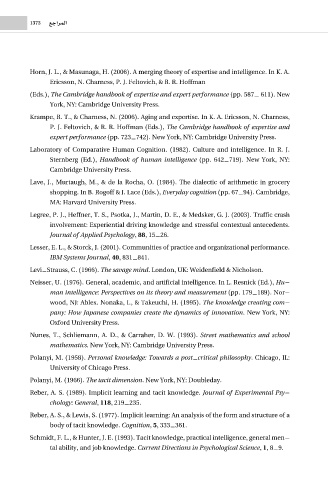Page 1374 - theCambridgehandbookofintelligence1
P. 1374
1373 ™LGôªdG
Horn, J. L., & Masunaga, H. (2006). A merging theory of expertise and intelligence. In K. A.
Ericsson, N. Charness, P. J. Feltovich, & R. R. Hoffman
(Eds.), The Cambridge handbook of expertise and expert performance (pp. 587- 611). New
York, NY: Cambridge University Press.
Krampe, R. T., & Charness, N. (2006). Aging and expertise. In K. A. Ericsson, N. Charness,
P. J. Feltovich, & R. R. Hoffman (Eds.), The Cambridge handbook of expertise and
expert performance (pp. 723-742). New York, NY: Cambridge University Press.
Laboratory of Comparative Human Cognition. (1982). Culture and intelligence. In R. J.
Sternberg (Ed.), Handbook of human intelligence (pp. 642-719). New York, NY:
Cambridge University Press.
Lave, J., Murtaugh, M., & de la Rocha, O. (1984). The dialectic of arithmetic in grocery
shopping. In B. Rogoff & J. Lace (Eds.), Everyday cognition (pp. 67-94). Cambridge,
MA: Harvard University Press.
Legree, P. J., Heffner, T. S., Psotka, J., Martin, D. E., & Medsker, G. J. (2003). Traffic crash
involvement: Experiential driving knowledge and stressful contextual antecedents.
Journal of Applied Psychology, 88, 15-26.
Lesser, E. L., & Storck, J. (2001). Communities of practice and organizational performance.
IBM Systems Journal, 40, 831-841.
Levi-Strauss, C. (1966). The savage mind. London, UK: Weidenfield & Nicholson.
Neisser, U. (1976). General, academic, and artificial intelligence. In L. Resnick (Ed.), Hu-
man intelligence: Perspectives on its theory and measurement (pp. 179-189). Nor-
wood, NJ: Ablex. Nonaka, I., & Takeuchi, H. (1995). The knowledge creating com-
pany: How Japanese companies create the dynamics of innovation. New York, NY:
Oxford University Press.
Nunes, T., Schliemann, A. D., & Carraher, D. W. (1993). Street mathematics and school
mathematics. New York, NY: Cambridge University Press.
Polanyi, M. (1958). Personal knowledge: Towards a post-critical philosophy. Chicago, IL:
University of Chicago Press.
Polanyi, M. (1966). The tacit dimension. New York, NY: Doubleday.
Reber, A. S. (1989). Implicit learning and tacit knowledge. Journal of Experimental Psy-
chology: General, 118, 219-235.
Reber, A. S., & Lewis, S. (1977). Implicit learning: An analysis of the form and structure of a
body of tacit knowledge. Cognition, 5, 333-361.
Schmidt, F. L., & Hunter, J. E. (1993). Tacit knowledge, practical intelligence, general men-
tal ability, and job knowledge. Current Directions in Psychological Science, 1, 8-9.

